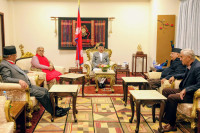Opinion
Launch into cyberspace
The then Royal Nepal Academy of Science and Technology (Ronast) and a private company, Mercantile Office Systems, brought the internet to Nepal in 1992.
Samaya Lama
The then Royal Nepal Academy of Science and Technology (Ronast) and a private company, Mercantile Office Systems, brought the internet to Nepal in 1992. Since then, the number of internet users has increased drastically and continues to swell. According to the 2017 Management Information System report published by the Nepal Telecommunications Authority, internet penetration has increased to more than 18.22 percent of the population.
Nepal is a least developed country, and non-governmental organisations (NGOs) play a key role in the delivery of services and products in remote regions where government presence is minimal. Against this backdrop, NGOs need to be connected to the internet to reach a wider section of the population. However, there is no data about the number of NGOs accessing the internet in Nepal. According to the Social Welfare Council, there are 46,235 NGOs registered in Nepal. Among them, many don’t have websites or email addresses.
Access key for awareness
The 2017 Global NGO Online Technology Report published by Nonprofit Tech for Good says that 92 percent of global NGOs maintain websites. According to its survey of 4,908 NGOs in Africa, Asia, Australia and Oceania, Europe, North America and South America, 32 percent use social media strategy. This study provides an updated set of benchmarks for success in online technology for NGOs by continent. Most global NGOs use technology to publish advertisements, create online awareness, raise funds, recruit personnel and organise campaigns. According to the report, 88 percent of global NGOs agree that social media is effective for creating social change and communicating with their supporters.
By comparison, the level of internet access among Nepali NGOs is low. NGOs can make their data and work details accessible to the public by putting them on their websites. This allows people to access the information from any corner of the world. The Nepal government has established an online Aid Management Platform to showcase bilateral and multilateral aid projects. This portal can be accessed from anywhere in the world. This is one of the best examples of showing the accountability of an organisation or the government via technology. If an NGO uploads its work details to its website, its supporters will not have to visit the office to obtain the information. They can get it on the web. NGOs will also be able to gain global supporters and credibility because of internationalisation of their work details through the web.
Coffee shops are the new offices
In Nepal, we doubt the existence of using technology to promote non-profit work. But such NGOs do exist around the world. Some examples of such NGOs are Avaaz.org, Getup, SumofUs, Jhatkaa.org and Moveon.org. All of them have one thing in common: They are predominantly tech NGOs and they do online campaigns. In addition to that, these organisations work virtually from cafes and libraries around the world with the support of their global staff. These tech-savvy NGOs are challenging growing threats to the environment, rule of law and human rights in their countries or globally. They use the internet for the purpose of recruiting, organising, sensitising, fundraising and mobilising people.
The internet currently plays a significant role by creating markets for social causes and connecting funding agencies to them. It is easy to develop an online platform where organisations can create fundraising campaigns for a cause. Putting a cause on the internet for fundraising allows it to reach a wider audience. There is a chance of attaining greater success compared to traditional fundraising campaigns which generally involves pitching to donors. In today’s globalised world, if all NGOs from Kathmandu to Kalikot are connected via the internet and all of them have websites, there is a greater chance of getting funds and sharing their work globally. The government can play an important role to increase the use of the internet among NGOs. It can make a policy requiring each and every NGO to have a website to be registered. The Social Welfare Council can check whether the NGOs being registered have their own websites or not.
Likewise, the NGO Federation of Nepal can provide free web design courses and web techniques to their newly registered and existing members for the purpose of motivating them and scaling up their operations. In addition to that, NGOs themselves should allocate a certain amount of funds to empower their organisations in terms of the internet and technology. If this happens, the numerous NGOs in Nepal can have better access to marginalised people than before. If accessibility increases, performance will also increase, making Nepali NGOs more reliable, faster, efficient and pro-public. This is a technologically driven world, and technology can overcome social problems if utilised properly by social organisations.
- Lama is a director of Garjan-Nepal, a non-profit organisation based in Nepal




 11.12°C Kathmandu
11.12°C Kathmandu










